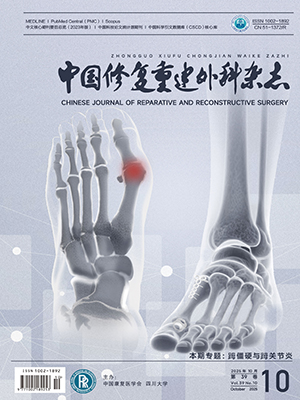| 1. |
Saavedra M, Sepúlveda M, Jesús Tuca M, et al. Discoid meniscus: current concepts. EFORT Open Rev, 2020, 5(7): 371-379.
|
| 2. |
Kocher MS, Logan CA, Kramer DE. Discoid lateral meniscus in children: diagnosis, management, and outcomes. J Am Acad Orthop Surg, 2017, 25(11): 736-743.
|
| 3. |
Ogata Y, Tabuchi K, Kinouchi S, et al. Knee extension deficit during gait and knee extensor weakness persisting after saucerization and repair of discoid lateral meniscus tears. Knee, 2024, 47: 171-178.
|
| 4. |
Sheasley JA, Kirby JC, Niu EL, et al. Characteristics and outcomes of operatively treated discoid lateral meniscus in pediatric and young adult patients: a multicenter study. Am J Sports Med, 2024, 52(11): 2758-2763.
|
| 5. |
Furumatsu T, Maehara A, Okazaki Y, et al. Intercondylar and central regions of complete discoid lateral meniscus have different cell and matrix organizations. J Orthop Sci, 2018, 23(5): 811-818.
|
| 6. |
Atay OA, Pekmezci M, Doral MN, et al. Discoid meniscus: an ultrastructural study with transmission electron microscopy. Am J Sports Med, 2007, 35(3): 475-478.
|
| 7. |
代瑞兰, 敖英芳. 前交叉韧带重建术后运动生物力学特征. 科技导报, 2022, 40(2): 27-35.
|
| 8. |
陆逸群, 吴悦, 刘振龙, 等. 前交叉韧带断裂及重建术后步态生物力学特征研究现状. 北京大学学报(自然科学版), 2024, 60(2): 377-392.
|
| 9. |
Harato K, Sakurai A, Kudo Y, et al. Three-dimensional knee kinematics in patients with a discoid lateral meniscus during gait. Knee, 2016, 23(4): 622-626.
|
| 10. |
Li Y, Wu Y, Zeng Y, et al. Biomechanical differences before and after arthroscopic partial meniscectomy in patients with semilunar and discoid lateral meniscus injury. Am J Transl Res, 2020, 12(6): 2793-2804.
|
| 11. |
Lin Z, Huang W, Ma L, et al. Kinematic features in patients with lateral discoid meniscus injury during walking. Sci Rep, 2018, 8(1): 5053. doi: 10.1038/s41598-018-22935-0.
|
| 12. |
林泽枫, 张余, 马立敏, 等. 外侧盘状半月板损伤患者膝关节在体运动学参数研究. 中国骨科临床与基础研究杂志, 2014, 6(5): 291-296.
|
| 13. |
Nishino K, Koga H, Koga Y, et al. Association of isometric quadriceps strength with stride and knee kinematics during gait in community dwelling adults with normal knee or early radiographic knee osteoarthritis. Clin Biomech (Bristol), 2021, 84: 105325. doi: 10.1016/j.clinbiomech.2021.105325.
|
| 14. |
葛永军, 宣勇, 穆帅, 等. 膝关节盘状半月板有限元模型的构建及生物力学分析. 中国矫形外科杂志, 2019, 27(22): 2071-2075.
|
| 15. |
Lee SW, Chun YM, Choi CH, et al. Single-leaf partial meniscectomy in extensive horizontal tears of the discoid lateral meniscus: Does decreased peripheral meniscal thickness affect outcomes? (Mean four-year follow-up). Knee, 2016, 23(3): 472-477.
|
| 16. |
Gamble JG, Abdalla AB, Meadows MG, et al. Radial width of the lateral meniscus at the popliteal hiatus: relevance to saucerization of discoid lateral menisci. Am J Sports Med, 2022, 50(1): 138-141.
|
| 17. |
Liu W, Sun X, Liu W, et al. Finite element study of a partial meniscectomy of a complete discoid lateral meniscus in adults. Med Eng Phys, 2022, 107: 103855. doi: 10.1016/j.medengphy.2022.103855.
|
| 18. |
Shen X, Lu M, Liu M, et al. Effect of residual volume after surgery of the discoid lateral meniscus on tibiofemoral joint biomechanics: a finite element analysis. J Orthop Surg Res, 2024, 19(1): 43. doi: 10.1186/s13018-023-04522-w.
|
| 19. |
Yokoe T, Ouchi K, Matsumoto T, et al. Effect of the volume of resected discoid lateral meniscus on the contact stress of the tibiofemoral joint: A finite element analysis. Knee, 2023, 42: 57-63.
|
| 20. |
傅德杰, 杨柳, 郭林. 半月板损伤与下肢力线. 中国矫形外科杂志, 2021, 29(4): 330-333.
|
| 21. |
Kim SJ, Bae JH, Lim HC. Does torn discoid meniscus have effects on limb alignment and arthritic change in middle-aged patients? J Bone Joint Surg (Am), 2013, 95(22): 2008-2014.
|
| 22. |
李光曦. 关节镜下成形缝合术治疗完全型盘状半月板损伤的临床观察. 郑州: 郑州大学, 2013.
|
| 23. |
史俊龙, 鹿战, 雷宏伟, 等. 下肢力线在盘状半月板损伤应用的研究进展. 中国骨伤, 2020, 33(4): 383-387.
|
| 24. |
张普延. 关节镜下外侧盘状半月板切除对下肢力线的影响. 合肥: 安徽医科大学, 2018.
|
| 25. |
王雪松, 陈雪, 王成成, 等. 关节镜下外侧盘状半月板切除范围对单侧盘状半月板损伤患者下肢力线及膝关节功能的影响. 新乡医学院学报, 2019, 36(7): 619-622.
|
| 26. |
李明, 刘华, 章云峰, 等. 盘状半月板切除术对中老年患者下肢力线的早期影响. 中国骨与关节损伤杂志, 2018, 33(6): 575-578.
|
| 27. |
邓岳. 膝关节镜下半月板切除术对下肢力线影响的系统评价与META分析. 厦门: 厦门大学, 2019.
|
| 28. |
王骏飞, 蒋青, 陈东阳, 等. 半月板切除对下肢力线的影响. 中华骨科杂志, 2005, 25(8): 481-484.
|
| 29. |
Qiao Y, Zhang X, Wu C, et al. Prevalence and a correlation analysis of discoid meniscus and femoral trochlear dysplasia. BMC Musculoskelet Disord, 2023, 24(1): 923. doi: 10.1186/s12891-023-06958-x.
|
| 30. |
Kuwabara A, Kraus E, Fredericson M. Narrative review—Knee pain in the pediatric athlete. Curr Rev Musculoskelet Med, 2021, 14(3): 239-245.
|
| 31. |
Dong J, Xu H, Jin G, et al. The adaptive change of patellofemoral joint after arthroscopic discoid lateral meniscus plasty: An observational study. Medicine (Baltimore), 2018, 97(6): e9827. doi: 10.1097/MD.0000000000009827.
|
| 32. |
Zhang Z, She C, Li L, et al. Mid-term study on the effects of arthroscopic discoid lateral meniscus plasty on patellofemoral joint: An observational study. Medicine (Baltimore), 2022, 101(45): e31760. doi: 10.1097/MD.0000000000031760.
|
| 33. |
Chedal-Bornu B, Morin V, Saragaglia D. Meniscoplasty for lateral discoid meniscus tears: Long-term results of 14 cases. Orthop Traumatol Surg Res, 2015, 101(6): 699-702.
|
| 34. |
Hall M, Wrigley TV, Metcalf BR, et al. A longitudinal study of strength and gait after arthroscopic partial meniscectomy. Med Sci Sports Exerc, 2013, 45(11): 2036-2043.
|
| 35. |
Weber AE, Harris JD, Nho SJ. Complications in hip arthroscopy: A systematic review and strategies for prevention. Sports Med Arthrosc Rev, 2015, 23(4): 187-193.
|
| 36. |
Fan ZY, Wang Y, Dong QR, et al. Lateral patellar translation effects after arthroscopic partial meniscectomy of torn discoid lateral meniscus. Orthop Surg, 2014, 6(1): 38-41.
|
| 37. |
Wang J, Xiong J, Xu Z, et al. Short-term effects of discoid lateral meniscectomy on the axial alignment of the lower limb in adolescents. J Bone Joint Surg (Am), 2015, 97(3): 201-207.
|
| 38. |
Ganderup T, Jensen C, Holsgaard-Larsen A, et al. Recovery of lower extremity muscle strength and functional performance in middle-aged patients undergoing arthroscopic partial meniscectomy. Knee Surg Sports Traumatol Arthrosc, 2017, 25(2): 347-354.
|




